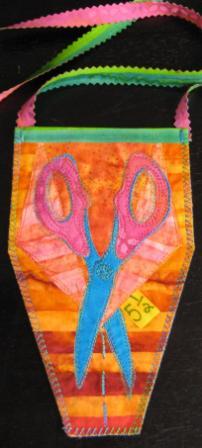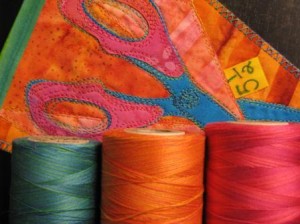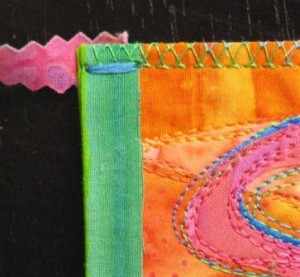I used Havel’s 5-1/2″ curved scissors as the pattern for my appliqué design. By tracing the actual scissors, I can easily identify what’s in the pocket. There are several techniques presented here, some may be new to you or a variation of something you do. This is an interesting and quick little project and the result is sweet.
Fabrics used are 100% cotton. This project uses small amounts of fabric, so instead of telling you yardage amounts, I’ll cut to the chase and give you the cut requirements. I used gorgeous batiks for mine; I think this project will work with vintage prints, hand dyes and novelty prints. The lining fabric is cotton sateen. The finished size is 4 ½ x 7 ½ inches.
Fusible web is used in this project. Choose your favorite (I use a lightweight paper backed fusible web.) Press according to the manufacturer’s directions. 1 yard is more than sufficient for this project. I like to have extra in case I make mistakes.
I use Havel’s Rotary cutter to cut my strips, rectangles and the triangles in this design. This big rotary cutter saves time and its large handle is easy to hold while working.
Cut:
Front piece, back piece and two lining pieces- 5”x 8”
Two 1 1/8” wide x 6” long strips of contrasting fabric for the top of pocket
1 1/8” wide strips from two contrasting fabrics for neck strap (mine is 34” long)
Cut two pieces of fusible web 5”x8”. Fuse to the wrong side of front and back pieces. Fuse the lining to the wrong side of the front and the back pieces.
Appliqué:
There are six fused appliqué pieces in this design. Trace the shapes onto fusible web. Press the shapes to desired fabrics. Cut and fuse them to the front of the pocket according to the drawing.
I use Havel’s 5 ½ inch curved scissors to cut my appliqué shapes. The scissors are very sharp. The curve and point on these scissors help me to get a clean cut in intricate shapes. They are also easy to handle while cutting because they are a perfect size.
Free-Motion Stitching:
I used a free-motion stitch technique to stitch the appliqué pieces to the front of the pocket and to add details. I used three different cotton multi-color threads (Star threads from my own design collection).
If you don’t want to free-motion stitch, you can use a very tiny zigzag or buttonhole stitch on your sewing machine. Other options are to use textile paints along the edges or don’t finish them at all and let the fusible web do its job.
Assemble the Pocket:
Place the front and back pieces of pocket, wrong sides together. Trim the front and back together according to the drawing. I use Havel’s big rotary cutter for this process. You may draw the lines and use big sharp shears instead.
Cut two strips of fusible web 1”x 6”. Fuse to the top contrasting strips. This is the green fabric strip at the top of the pocket. * Fold the strip lengthwise over the top of the front of the pocket. Trim the strip along the width if necessary to the design. Press to fuse the strip over the top pocket edge…pressing and fusing the strip to itself at the ends. Trim the ends to the size of the pocket. Repeat from * for the back piece.
Use an edge stitch to sew the pocket pieces together. You can use a serger for this. I used an overcast stitch with a special edge foot. Use a decorative thread in a contrasting color for a pretty finish.
Neck Strap:
You must determine the length of your strap. Fuse strips of two contrasting fabrics together. This creates a double sided fabric strap which has body and strength. I use Havel’s Pinking Shears to cut a lovely decorative edge as I trim the strap to about ½ inch width.
Use a wide bar tack stitch on your sewing machine to attach the strap.
Double fuse Tag:
Fuse a small rectangle of fusible web to the back of a yellow fabric. Pull the paper off, fold the rectangle to form a square with wrong sides together, then press to fuse.. Trim to the desired size. Write the scissor identification, “5 ½” or your initials with a permanent pen. Use good fabric glue to glue in place according to the drawing.
Enjoy this scissor pocket and make one for your sister! (I did)
Stitch On!
Terry White
Instructions for Artistic Scissors Pocket
by Terry White

Artistic Scissors Pocket
I used Havel’s 5 ½ inch curved scissors as he pattern for my appliqué design. By tracing the actual scissors, I can easily identify what’s in the pocket. There are several techniques presented here, some may be new to you or a variation of something you do. This is an interesting and quick little project and the result is sweet.
Fabrics used are 100% cotton. This project uses small amounts of fabric, so instead of telling you yardage amounts, I’ll cut to the chase and give you the cut requirements. I used gorgeous batiks for mine; I think this project will work with vintage prints, hand dyes and novelty prints. The lining fabric is cotton sateen. The finished size is 4 ½ x 7 ½ inches.
Fusible web is used in this project. Choose your favorite (I use a lightweight paper backed fusible web.) Press according to the manufacturer’s directions. 1 yard is more than sufficient for this project. I like to have extra in case I make mistakes.
I use Havel’s Rotary cutter to cut my strips, rectangles and the triangles in this design. This big rotary cutter saves time and its large handle is easy to hold while working.
Cut:
Front piece, back piece and two lining pieces- 5”x 8”
Two 1 1/8” wide x 6” long strips of contrasting fabric for the top of pocket
1 1/8” wide strips from two contrasting fabrics for neck strap (mine is 34” long)
Cut two pieces of fusible web 5”x8”. Fuse to the wrong side of front and back pieces. Fuse the lining to the wrong side of the front and the back pieces.
Appliqué:

Using Free Motion Stitching
There are six fused appliqué pieces in this design. Trace the shapes onto fusible web. Press the shapes to desired fabrics. Cut and fuse them to the front of the pocket according to the drawing.
I use Havel’s 5 ½ inch curved scissors to cut my appliqué shapes. The scissors are very sharp. The curve and point on these scissors help me to get a clean cut in intricate shapes. They are also easy to handle while cutting because they are a perfect size.
Free-Motion Stitching:
I used a free-motion stitch technique to stitch the appliqué pieces to the front of the pocket and to add details. I used three different cotton multi-color threads (Star threads from my own design collection).
If you don’t want to free-motion stitch, you can use a very tiny zigzag or buttonhole stitch on your sewing machine. Other options are to use textile paints along the edges or don’t finish them at all and let the fusible web do its job.
Assemble the Pocket:
Place the front and back pieces of pocket, wrong sides together. Trim the front and back together according to the drawing. I use Havel’s big rotary cutter for this process. You may draw the lines and use big sharp shears

Assembling the Pocket and Neck Strap
instead.
Cut two strips of fusible web 1”x 6”. Fuse to the top contrasting strips. This is the green fabric strip at the top of the pocket. * Fold the strip lengthwise over the top of the front of the pocket. Trim the strip along the width if necessary to the design. Press to fuse the strip over the top pocket edge…pressing and fusing the strip to itself at the ends. Trim the ends to the size of the pocket. Repeat from * for the back piece.
Use an edge stitch to sew the pocket pieces together. You can use a serger for this. I used an overcast stitch with a special edge foot. Use a decorative thread in a contrasting color for a pretty finish.
Neck Strap:
You must determine the length of your strap. Fuse strips of two contrasting fabrics together. This creates a double sided fabric strap which has body and strength. I use Havel’s Pinking Shears to cut a lovely decorative edge as I trim the strap to about ½ inch width.
Use a wide bar tack stitch on your sewing machine to attach the strap.




